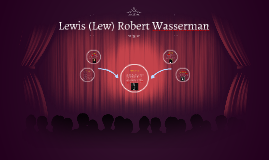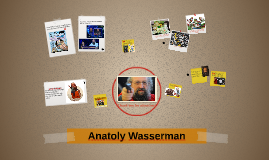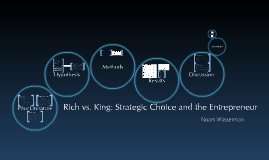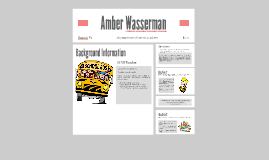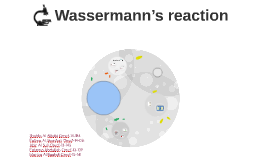MS&E 372 Presentation--Wasserman
Transcript: Appendix Economic theory: profit maximization motivates entrepreneurship (Scitovszky, 1943) 1. Prior literature identify profit and control as two motives for entrepreneurship (Scitovsky, 1943; Amit, et. al., 2000); I show that these two motives drive entrepreneurs to make very different strategic decisions H6: Entrepreneurs who hire an executive with prior ties to them will have more valuable equity stakes than entrepreneurs who lack prior ties to their executives Data source: membership lists of tech councils, VentureOne, firms' client lists, recommendations from investors Returns to entrepreneurship are no higher than returns to public equity (Moskowitz &Vissing-Jorgensen, 2002) Entrepreneurs are motivated by chance to play central role in driving and controlling growth of their company (Carland, et. al., 1984; Begley & Boyd, 1987) H4: Weakly Supported Results Sample and Data Source Gap in Literature The Rich vs. King Tradeoff Contributions Hypothesis Is Profit the Only Motive? Discussion Research Question H1: Strongly Supported H4: Entrepreneurs who provide the initial capital for their ventures will have more valuable equity stakes than do entrepreneurs who do not provide the initial capital Variables and Measurements Control Motive H6: Supported How alternative motives drive entrepreneurs towards different strategic decisions H3: Supported There are other motivations for entrepreneurship (Amit, et. al., 2000; Sapienza, et. al., 2003) 1. Pick the strategy that matches one's motivations and stick with it Self-employed people earn less and have lower earnings growth than people in paid employement (Hamilton, 2000) Questions? Final data set: 460 private tech companies 127 from 2000, 155 from 2001, 178 from 2002 Noam Wasserman Personal profit drives private enterprise (Smith, 1991 ed.; Schumpeter, 1942; Kirzner, 1973) Methods How to be Rich and Regal? Data gathering mechanism: online survey from 2000-2002 H2: Strongly Supported Results Rich motivation: trade more control for top-tier investors that can quickly grow the company Prior Literature Unit of analysis: core entrepreneurs of each company (1 per company) H1: If the entrepreneur still controls the board of directors, the value of the entrepreneur's equity stake will tend to be lower than if the entrepreneur has given up control of the board H5: Supported 3. Prior literature identify certain variables that moderate organizational processes and outcomes (Hitt & Tyler, 1999; Lin, 1999); I combine these conclusions with the strategic decision literature and specify how the Rich vs. King tradeoff is moderated H3: Entrepreneurs who had general management experience before founding their ventures will have more valuable equity stakes than do entrepreneurs who lack general management experience Rich vs. King: Strategic Choice and the Entrepreneur Sample selection: entrepreneurs that raised at least 1 round of funding Better investors want more control, vice versa (Coff, 1999; Bhide, 2000) H1: If the entrepreneur still controls the CEO position, the value of the entrepreneur's equity stake will tend to be lower than if the entrepreneur has given up control of the CEO position 2. Prior literature discuss relationship between the two motives in isolated cases (Abetti, 2005); I propose formal theory and mechanism for Rich vs. King tradeoff How are differential strategic decisions related to each other, and what moderates these relationships? H5: Entrepreneurs who take money from an investor with prior ties to them will have more valuable equity stakes than entrepreneurs who lack prior ties to their investors Implications for Entrepreneurs Many entrepreneurs have strong desire to "remain master of their own destiny" (Abetti, 2005) How do alternative motivations drive entrepreneurs' differential strategic decisions? Investors demand control rights to protect their investments (Tyebjee & Bruno, 1984; Sahlman, 1990) The Rich and the King King motivation: settle for second-tier investors to keep more control 2. Utilize one's financial, social, and human resources as much as possible Profit Motive






